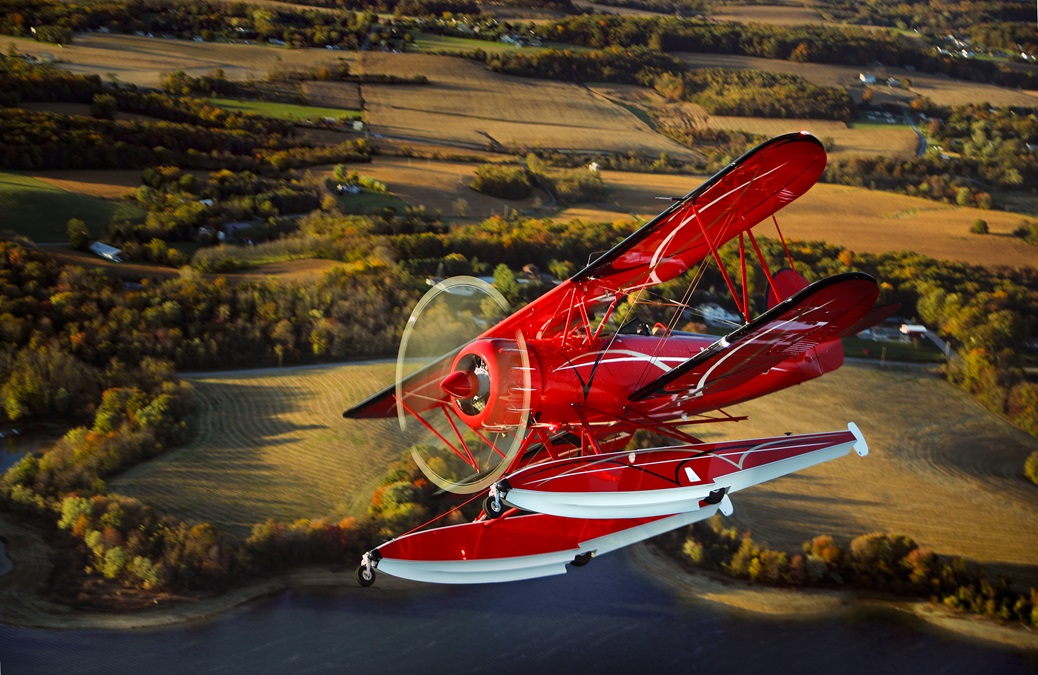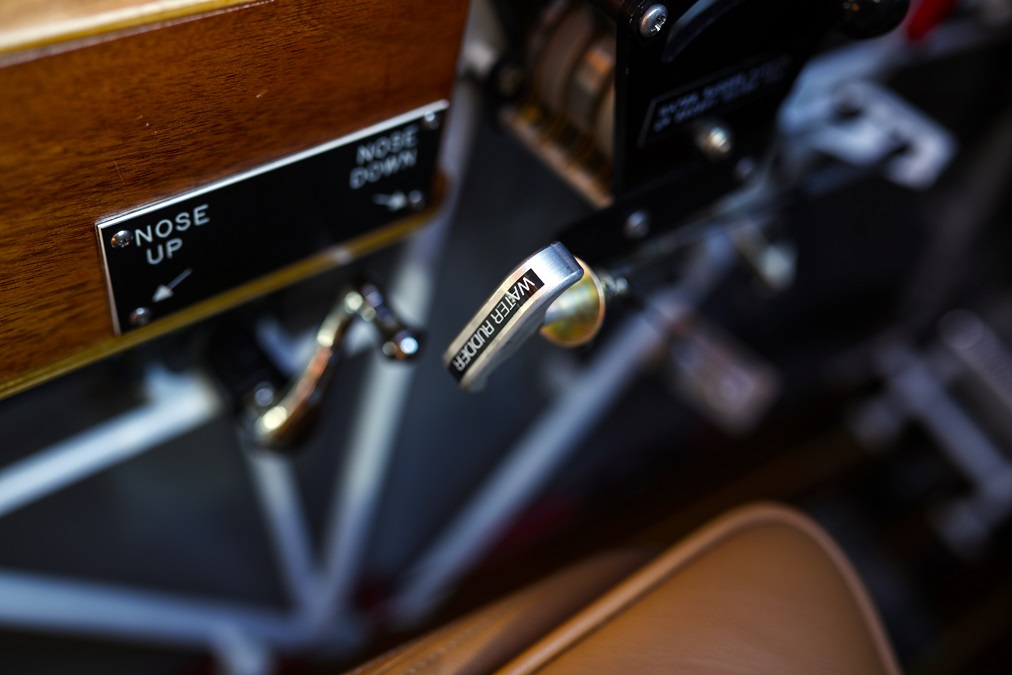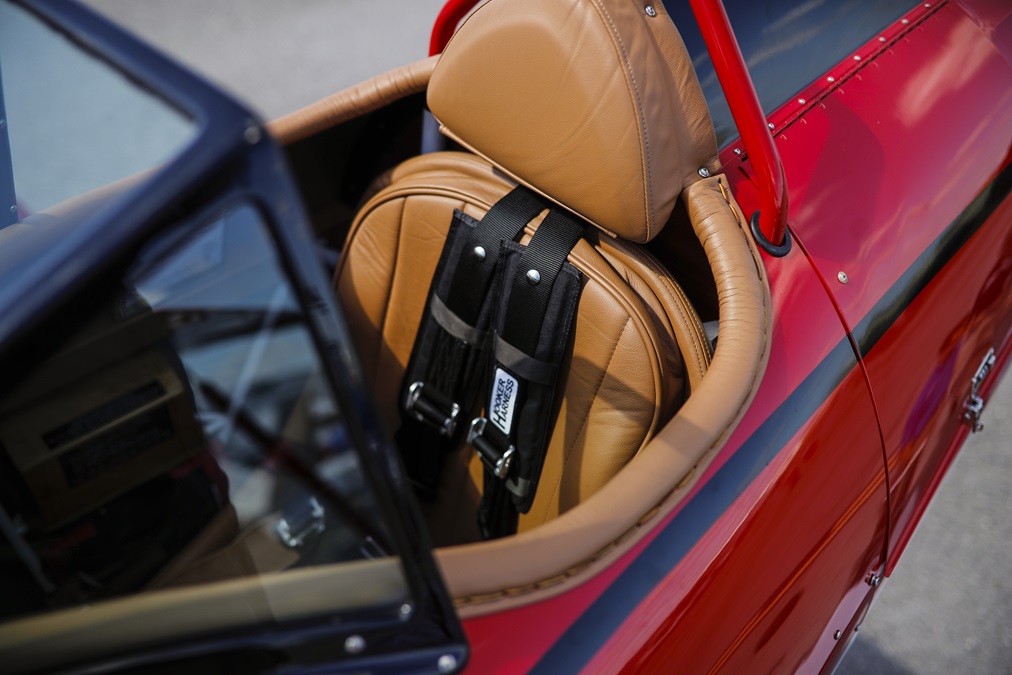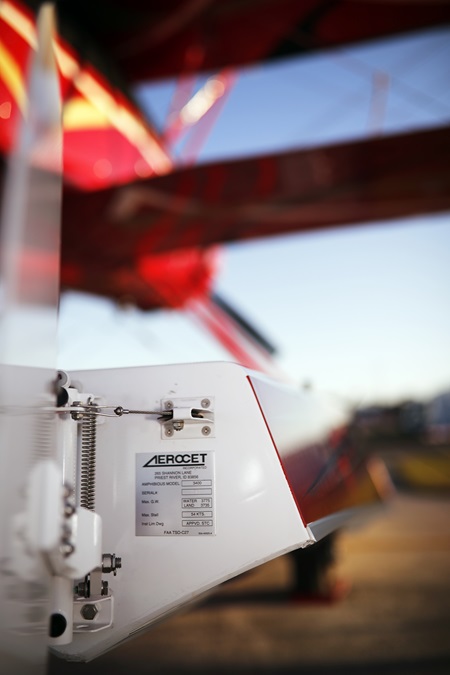Mind bender
Waco's irresistible amphibian
This Waco YMF–5F (N56ED) is the first of the modern biplanes handmade in Battle Creek, Michigan, to set upon amphibious floats, and it’s a mind bender. On its four wheels, the big, candy-apple-red biplane is mountainous. On the water, it glides serenely, its 300-horsepower radial engine rumbling with the calm assurance that it can roar into the air at a moment’s notice. And wherever it goes, this rock-star biplane turns pilots into paparazzi as they reflexively grab their smartphones to record photos and video.
“If you want to be an anonymous hermit, this isn’t the airplane for you,” said Peter Bowers, president of Waco Aircraft Corp., and the catalyst behind this first-of-its-kind air- and watercraft. “Wherever you go, whether it’s an airport or a lake, people are going to be attracted to the airplane. They’re not just going to have questions for you. They’re going to swarm you.”
I flew with Bowers from AOPA headquarters in Frederick, Maryland, to the season-ending AOPA Fly-In at Peter O. Knight Airport in Tampa, Florida, in the float Waco, and he wasn’t exaggerating about the airplane’s magnetism. Fishermen on lakes, watercraft riders on rivers, and especially pilots at airports all approached the airplane with the same mix of awe, curiosity, and gushing admiration. They’re powerless to resist the airplane’s gravitational pull, and so am I.
From the moment in 2016 that Bowers shared design sketches of the airplane while it was still a concept, I couldn’t stop thinking about it. And when he offered to let me evaluate it during an all-day, 750-nm trip along the Eastern seaboard, my answer was a foregone conclusion: I wouldn’t miss it for anything.
A tale of two flights
By the time I finally made the big climb onto the Aerocet floats and stepped up into the Waco’s spacious, leather-lined rear cockpit, I had a pretty good idea what to expect from a performance standpoint. I’d flown wheeled versions of the YMF–5 extensively during a long-ago weekend job as a rides pilot, so the cockpit and its surroundings felt instantly familiar, but not identical. The biggest difference was the prominent landing gear lever and gear position indication system that’s placed front and center on the instrument panel. Having the landing gear in the right position is critical in an amphibious floatplane, and the Waco has both visual and aural warnings to ensure the pilot gets it right.
The water rudder extension and retraction T-handle, mounted low on the left side of the cockpit, takes a few seconds to figure out how to operate. The floatplane also has a constant-speed, two-blade MT propeller, and that extra lever on the throttle quadrant was new to me because all the YMFs I’d ever flown had fixed-pitch props.
Startup was normal for a carbureted engine, and taxiing was novel because, unlike tailwheel biplanes, the incredibly tall vantage point and flat attitude allows you to see where you’re going—a radial biplane first for me. Differential braking is required for turns using standard, hydraulic toe brakes.
The surface wind was calm during my first takeoff, and the airplane tracked straight ahead during the ground roll. There’s no discernable left-turning tendency as the airplane accelerates, and the view ahead is unobstructed. Steady back-pressure on the elevator lifted the front wheels at 55 mph indicated, and the main wheels came off the ground at 65 mph.
Gear retraction takes about 10 seconds, and with the advisory system showing all four lights up/blue, we leveled off at 3,500 feet msl for the southward journey. With the engine and propeller set for cruise at 1,950 rpm, 21 inches manifold pressure, and a rich-of-peak mixture setting, the Waco flew at 95 mph indicated (102 mph true) while consuming 14.5 gallons of avgas per hour.
The floatplane has 44 gallons of usable fuel in two tanks located in the top wing, and the pilot can feed the engine from either or both tanks simultaneously. We typically flew up to 2.5 hours on the cross-country legs of the trip.
In the air, the float Waco is surprisingly similar to the wheeled versions. The climb rate of about 1,000 fpm is about the same, and the cruise speed just shy of 100 mph is almost identical. Of course, the YMFs I’d previously flown had 275-horsepower engines and fixed-pitch wood props. This one has a 300-horsepower engine and a constant-speed prop. Bowers said the airplane’s speed penalty for carrying the floats is about 10 mph at cruise.
From the rear cockpit, the biplane’s lower wings almost completely block the view of the floats in flight. Front-seaters—the YMF can carry two in the front cockpit—can see landing gear position indicators, but not the rear-seat pilot. Bowers said he’s considering adding mirrors to give the back-seater a look at the wheel position.
The airplane’s handling qualities are more sedate than wheeled versions. The roll rate is slightly slower, and pitch and roll forces seem heavier but harmonious. Yaw stability is surprisingly good, even without a ventral fin or other aerodynamic modifications that are often required for floatplane conversions.
Runway landings are childishly simple. Put the landing gear down, hold 85 mph on final, round out, and you’ll touch down a few seconds before you expect to. (The airplane’s just that tall.) Once the main wheels are in contact with the runway, the airplane tracks straight as an arrow. Even in moderate crosswinds, the float Waco’s wide wheelbase makes it preternaturally stable.
On the water, there’s more going on, but not a lot more. We had ideal conditions with broad expanse of fresh water; a steady, eight-knot breeze that rippled the surface; and unobstructed approaches.
With the wheels tucked away, an approach speed of 80 mph provided ample time in the flare. The pilot sets a slightly nose-up landing attitude, then adds full nose-up elevator once the floats touch down.
After the airplane settled, a pull of the T-handle lowered the water rudders for steering.
The water rudders provide excellent steering authority, and the airplane shows no hesitation in turning downwind on the water. The Aerocet 3400L floats are the same model used for heavier Cessna 182s and 206s, and they rode high in the water with the lightly loaded biplane. There were no waves of any significance to test the airplane’s stability on the water, but intentionally crossing our own wake hardly rocked the Waco at all.
Takeoffs on the water are short, in both time and distance traveled. The Waco accelerates briskly at full power, and with full back-pressure on the stick, it’s on the step in about three seconds. Then the pilot neutralizes the elevator and, as the airplane accelerates, adds light forward pressure on the stick to keep the floats at the optimum angle.
With four ailerons, there’s plenty of roll authority to begin raising a float at 60 mph, and the Waco lifts off at 65 mph. Under the ideal, sea-level conditions described here, the Waco’s water run took about 13 seconds and 700 feet.
Waco water ops are pure exhilaration.
Craftsmanship
Those who know Waco well are likely to realize this isn’t the first floatplane YMF. Waco built a non-
amphibious, full-time floatplane in 1999 but didn’t seek FAA certification. Still, those involved in the program learned a great deal from it.
“That first floatplane had a less powerful engine, a less efficient fixed-pitch prop, and smaller floats,” Bowers said. “Also, it was a full-IFR airplane that was significantly heavier, so its performance suffered.”
This time, in addition to the bigger engine and constant-speed prop, Waco lightened the airframe and saved weight on the panel, interior, and wherever else the company could. It even switched to a 14-volt electrical system from a 28-volt for a smaller battery.
“It’s also easier to jump a 12-volt battery on a lake with a ski boat than it is to bring a 28-volt power cart from the FBO,” Bowers said.
All the metal parts of the airplane are treated with corrosion protection, and it makes extensive use of stainless steel hardware that resists rust.
The floatplane has a 462-pound payload with full fuel, and Bowers said he hopes to sell some to ride operators in seaside locations, resorts, and private individuals. It’s also creating more interest in high-powered, lightweight versions of the company’s wheel airplanes, and showcases the craftsmanship of the company’s technicians who are widely recognized for their flying works of art.
This first amphibious Waco floatplane was flying under the Experimental category at the time of our evaluation, and there was more testing to do before the FAA added the airplane’s many mods to the company’s type certificate. Bowers said Waco intends to keep this N56ED for flight testing and marketing, and learn how to improve it over time.
Waco also builds Great Lakes biplanes, and Bowers said several people have inquired about whether the company will make a floatplane version of that beloved trainer. (His nonanswer answer: “I’m thinking about it.”)
N56ED was scheduled to remain in Florida for the 2017/2018 winter and campaign throughout the Southeast.
Bowers said the real motivation for building the first amphibious Waco was as much personal, however, as commercial.
“I got a floatplane rating myself last year in Cadillac, Michigan, and it was a lot of fun,” he said. “I figured a Waco floatplane would be a hell of a lot of fun. And I was definitely right about that.”AOPA
Email [email protected]

 The Jacobs Aircraft Engine Company closed its doors in the early 1970s—so where do the gleaming radials on new Waco biplanes come from?
The Jacobs Aircraft Engine Company closed its doors in the early 1970s—so where do the gleaming radials on new Waco biplanes come from?










